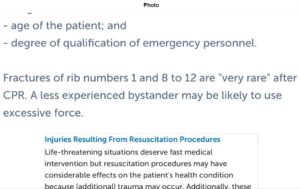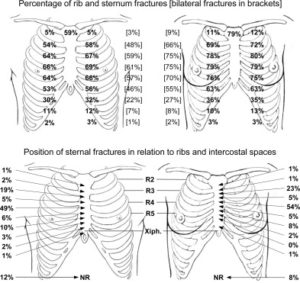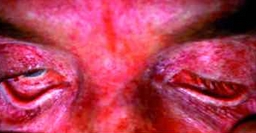

As TMD continues its independent investigation of the death of late SOUNDGARDEN frontman, Chris Cornell, tonight we will examine more closely the 9 fractured ribs Chris suffered on the night of May 17, 2017 according to the autopsy done by medical examiner Theodore Brown. This will be both a forensic analysis and a 100% debunking of the belief that these extensive internal injuries came from CPR being performed on the rock legend… along with falling to the ground after being partially suspended to a door.
According to LiveScience.com,
Bone is extraordinarily strong — ounce for ounce, bone is stronger than steel, since a bar of steel of comparable size would weigh four or five times as much. A cubic inch of bone can in principle bear a load of 19,000 lbs. (8,626 kg) or more — roughly the weight of five standard pickup trucks — making it about four times as strong as concrete.
Still, whether or not bone actually withstands such loads depends heavily on how quickly force is delivered.

“When you perform CPR, you can give chest compressions and not break any ribs, but if you apply the same amount of force quickly instead of slowly, and you can end up having rib fractures,” the expert explained.
According to a 2012 Reuters report:
“A significant portion of the people who receive cardiopulmonary resuscitation may end up with broken ribs or other bones as a result, according to Korean researchers, who also found that some types of patients could be at higher risk than others.
In a study of people admitted to Korean hospitals, close to one third of those resuscitated after having CPR ended up with at least one broken rib, while about four percent had a broken breast bone, or sternum.
Dr. Michael Sayre, a spokesperson for the American Heart Association and a professor at the University of Washington in Seattle, said broken ribs are to be expected when doing CPR.
For the new study, researchers led by Dr. Min Joung Kim from the Yonsei University College of Medicine in Seoul, gave CT scans to patients brought to eight hospital emergency departments between January and June of 2011. All had successful CPR either before getting to the hospital or in the ED.
Of the 71 patients scanned, the researchers found that 22 had at least one broken rib and 14 had multiple breaks. Only three patients had broken breast bones – a plate of cartilage that connects the ribs – and some had other injuries besides broken bones, such as blood in the chest wall or bruised lungs.”
Fracture: A break in bone or cartilage. Although usually a result of trauma, a fracture can be the result of an acquired disease of bone, such as osteoporosis. (Medicine.net)
According to a male nurse who offered his professional opinion:
“Cardio-Pulmonary Resuscitation, CPR, or “chest compressions” as they are commonly known. CPR is a potentially life saving sequence of moves that are performed when a patient’s heart stops beating appropriately. If this happens to you and you are in hospital, CPR will most likely be given to you by a nurse. as they are the staff members who are usually always around. Sometimes it is very quick (say 2 minutes worth) – before gel pads are applied for defibrillation; or sometimes it goes on for hours, particularly if your heart is in a rhythmn that is not suitable for shocking. Basically what will happen is that the nurse will use heel of their hands on your sternum, and with straight arms push down, stimulating the heart to perform a modified pumping action. Current recommendations suggest the chest needs to be compressed by a third of its depth, with 30 compressions a cycle or roughly 100 compressions per minute.
Now let me tell you this. I am a big guy. I weigh over 100kg and I can easily bench-press 70kgs (the weight of an average human). If your heart stops beating and you arrest, you want me on your team. I have a reputation on my ward for doing it well, and young interns never fail to comment as they monitor the patient whose chest I am pounding. “MMmmm good output Rick” they croon (No joke). The thing is though, it is ugly; really ugly. Chances are I will break one, two, even three of your ribs depending on how old you are. You will also have tube stuck down your throat to support your airway and help you breath, and be stabbed from several sides as doctors try to access your veins. Drugs like adrenaline, atropine and amiodarone will be pumped into your body with no hesitation. With the loss of consciousness and all the physical man-handling, you are likely to wet yourself and/or open your bowels. You will be stripped bare, and most likely you will be alone, without your friends or family. The average survival to discharge rate of someone surviving CPR (that is you get to go home) sits at around 18%.”

According to Chris Cornell’s autopsy, the musician suffered much more damage than is normally associated with CPR. Here are Theodore Brown’s own words:
“The soft tissues and muscles of the chest had multiple foci of hemorrhage. The anterior aspects of the right second through sixth and left second through fifth ribs were fractured. The anterior mediastinal soft tissues were hemorrhagic.The anterior aspects of the right and left lungs had focal areas of hemorrhage.”
That is not 1, 2 or 3 rib ‘breaks’. That is 9. Triple the amount of damage.
The amount of weight the chest can sustain is directly related to the strength of the muscles in the chest. Once you strip away the muscle, the bones in and of themselves, unless otherwise effected by some condition or disorder are going to have substantially less variance in strength from person to person.
It’s the flesh surrounding bone that makes the bone strong. It takes about 15 PSI to crack the skull, while it takes around 7 PSI to crack a rib.
While it is fully understood that rib fractures in men happens about 50% of the time. That being said,
when we look more closely at the case of Chris Cornell and what the experts tell us about the reality of what really happens when it is performed on a human being, clearly the internal damage Chris sustained did not all occur from CPR being performed on him.
Now we know Chris is said to have fallen to the floor once the door he was ‘partially suspended’ from was allegedly kicked in by his bodyguard and that could certainly cause some further injury.
But are we to truly believe that would cause the additional SIX FRACTURES?
According Merck online, typically, rib fractures result from blunt injury to the chest wall, usually involving a strong force (eg, due to high-speed deceleration – say a crash crash, etc. – a baseball bat, a major fall off the roof of a house while hanging Christmas lights).
However, sometimes in the elderly, only mild or moderate force (eg, in a minor fall) is required. If 2 adjacent ribs fracture in 2 separate places, the breaks in each rib result.
As the medical science tells us, along with the expert testimony provided, fracturing or breaking ribs is rather difficult to do and will normally only happen when someone totally inexperienced performs CPR on a person for the first time or if the victim is much older than Chris Cornell was.
Chris is said to have received CPR from his bodyguard, who would have been trained on delivering this type of critical first aid, as was the first responding medic and subsequent EMS workers who arrived to the scene.
And we know that according to the EMS call, Chris was obviously not being worked on very hard since the EMS remarks to dispatch were “Cold to the touch all over”… so how much CPR did they actually perform over a half hour period, knowing the rock star was long dead?
When being strangled to death, what is called ‘fight for flight’ response happens in the victim. They begin to shake back and forth violently in a struggle to remain alive. While the assailant uses one arm to perform a death choke, the victim may be bumped into the wall or other furniture that serves as the blunt force to that area of the chest.

(Pictured: The desk in room #1136)
Chris is said to have been watching his Apple TV according to his bodyguard when he was visited
in room #1136 at roughly 11:45PM on May 17th, as reported by People.
On the night of his death, a source claims that Cornell asked both security and an engineer to help him get his Apple TV system to work around 11:45 p.m. Says the source, “Chris was so adamant about getting his TV to work he called for backup assistance when security was unable to fix it. Someone so persistent about fixing a TV so they can watch their favorite show, focusing on something so mundane, is not a sign of someone planning to take their life.”

“When pressure is placed on the neck, the victim first experiences pain, followed by anxiety as the victim becomes distressed from a subjective sensation of difficulty breathing. With enough force to impair respiration, the victim will typically lose consciousness within 10-15 seconds. Obviously, the loss of consciousness is not solely due to apnea. It is likely that arterial obstruction, venous obstruction, and autonomic nervous system reflexes all play a role in the rapid loss of consciousness with strangulation.
The neck is vulnerable to external injury because it does not have bony protection and within its relatively small diameter course the airway, vascular supply to the brain, the spinal cord and other vital nerves, and the cervical vertebral column. External force can injure many of these important structures.”
The expert continues:
With strangulation, the initial presenting symptoms and physical signs may be deceptively minimal. It takes time for hemorrhage and edema to develop after compressive injuries, and the full clinical manifestations may not occur for 36 hours after the event.

(Pictured: Not Chris Cornell, A Strangulation Victim with Petechiae)
Petechiae (observed on Chris Cornell by the medical examiner) can occur at or above the area of compression and are most frequently reported on the face and conjunctiva. More extensive subconjunctival hemorrhage, is generally seen only after a particularly vigorous struggle between the victim and the assailant.
Chris was reportedly found in a torn shirt, had blood running out of his mouth, and the EMS on scene noted “signs of strangulation” and “head trauma”. If this was a clear cut suicide by hanging why is there so much damage on the body that can’t be explained away by the obvious?
Is it because maybe Chris Cornell did not take his own life?
Undoubtedly, the evidence looked at in the proper light now definitely points to someone taking his life for him, doesn’t it?

(Pictured: Bodyguard Martin Kirsten, The Man Paid To Protect Chris)
https://www.facebook.com/chriscornell
#TruthForChris





More Stories
HOUR OF PENANCE – “Sedition” to be Reissued on Vinyl
ELECTRIC TEMPLE – Debut Album Announced
SEPTICFLESH – 2025 North American Tour Dates